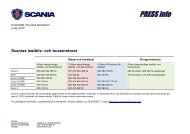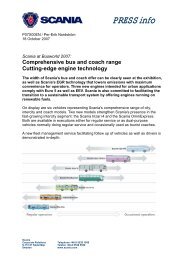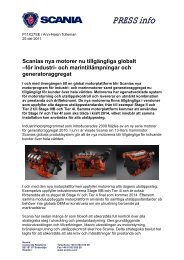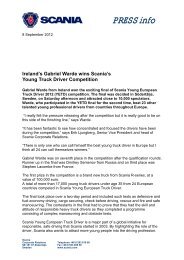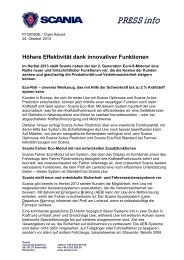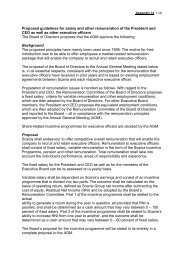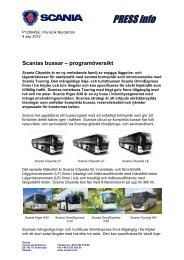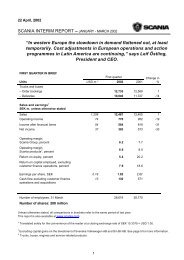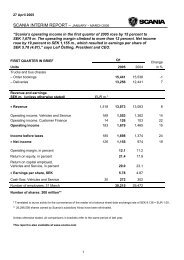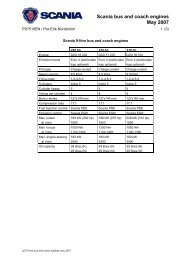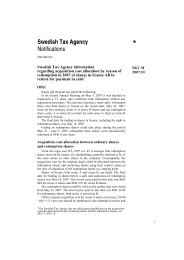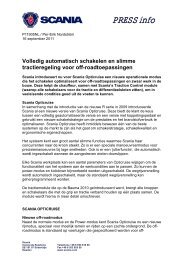Scania Annual Report 2011
Scania Annual Report 2011
Scania Annual Report 2011
Create successful ePaper yourself
Turn your PDF publications into a flip-book with our unique Google optimized e-Paper software.
126<br />
notes to the consolidated financial statements<br />
NOTE 30 Financial risk management<br />
Financial risk management in the scania group<br />
In addition to business risks, <strong>Scania</strong> is exposed to various financial<br />
risks in its operations. The financial risks that are of the greatest importance<br />
are currency, interest rate, credit and refinancing risk, which are<br />
regulated by a Financial Policy adopted by <strong>Scania</strong>’s Board of Directors.<br />
Credit risk related to customer commitments is managed, within<br />
established limits, on a decentralised basis by means of local credit<br />
assessments. Decisions on major credit commitments are made in<br />
corporate credit committees. Other risks are managed primarily<br />
at corporate level by <strong>Scania</strong>’s treasury unit. On a daily basis, the<br />
corporate treasury unit measures the risks of outstanding positions,<br />
which are managed within established limits in compliance with the<br />
Financial Policy.<br />
CURRENCY RISK<br />
Currency risk is the risk that changes in currency exchange rates will<br />
adversely affect cash flow. Changes in exchange rates also affect<br />
<strong>Scania</strong>’ s income statement and balance sheet as follows:<br />
– An individual company may have monetary assets and liabilities<br />
in a currency other than its functional currency, which are translated<br />
to the functional currency using the exchange rate on the<br />
balance sheet date. When settling monetary assets and liabilities,<br />
an exchang e rate differenc e arises between the exchange rate on<br />
the balance sheet date and on the payment date. All changes in<br />
exchange rates attributable to translation or settlement of monetary<br />
items are recognised in the income statement (transaction effect).<br />
– Revenue, expenses, assets and liabilities in a functional currency<br />
other than the reporting currency of the Parent Company (SEK) are<br />
translated at the average exchange rate during the year and the<br />
exchange rate on the balance sheet date, respectively. The effect<br />
that arises because the exchange rate on the balance sheet date is<br />
changed from the beginning of the year and the average exchange<br />
rate of the year deviates from the balance sheet rate is recognised<br />
in the translation reserve in other comprehensive income<br />
(translation effect.)<br />
During <strong>2011</strong>, 93 (94 and 93, respectively) percent of <strong>Scania</strong>’s sales<br />
occurred in countries outside Sweden. Since a large proportion of<br />
production occurs in Sweden, at costs denominated in Swedish krono r,<br />
this means that <strong>Scania</strong> has large net inflows of foreign currencies.<br />
During <strong>2011</strong>, total net revenue in foreign currencies amounted to<br />
about SEK 31,300 m. (25,800 and 19,800, respectively). The largest<br />
currencies in this flow were EUR, USD and RUB. The table on the next<br />
page shows currency exposure in <strong>Scania</strong>’s operating income in the<br />
most commonly occurring currencies.<br />
Currency exposure in operating<br />
income, Vehicles and Services <strong>2011</strong> 2010 2009<br />
Euro (EUR) 6,100 4,700 5,800<br />
US dollar (USD) 5,500 4,200 3,400<br />
Russian rouble (RUB) 4,500 1,500 700<br />
Brazilian real (BRL) 3,500 7,100 2,500<br />
British pound (GBP) 3,000 2,500 2,700<br />
Norwegian krone (NOK) 1,800 1,200 1,400<br />
Australian dollar (AUD) 1,100 1,000 900<br />
Danish krone (DKK) 1,100 900 1,100<br />
Swiss franc (CHF) 800 600 700<br />
Polish zloty (PLN) 700 100 – 300<br />
Korean won (KRW) 600 800 600<br />
South African rand (ZAR) 600 600 500<br />
Argentine peso (ARS) –1,200 –1,100 – 700<br />
Other currencies 2,500 1,500 800<br />
Total currency exposure<br />
in operating income 30,600 25,600 20,100<br />
Currency exposure in operating<br />
income, Financial Services <strong>2011</strong> 2010 2009<br />
Euro (EUR) 400 100 –300<br />
Other currencies 300 100 0<br />
Total currency exposure<br />
in operating income 700 200 –300<br />
Based on revenue and expenses in foreign currencies during <strong>2011</strong>,<br />
a one percentage point change in the Swedish krona against other<br />
currencies, excluding currency hedges, has an impact on operating<br />
income of about SEK 313 m. (258 and 198, respectively) on an<br />
annual basis.<br />
In Vehicles and Services, compared to 2010, the negative currency<br />
spot rate effects totalled about SEK 2,190 m. During 2010, currency<br />
hedging of future deliveries had an impact of about SEK 745 m. on<br />
income. During <strong>2011</strong>, no future deliveries were hedged. Compared to<br />
2010, the total negative currency rate effect was thus SEK 2,935 m.<br />
According to <strong>Scania</strong>’s policy, <strong>Scania</strong>’s Management may hedge<br />
future currency flows with a hedging period varying between 0 and 12<br />
months. Maturity over 12 months is decided by the Board of Directors.<br />
When currency risks are hedged, currencies are mainly sold by means<br />
of forward contracts, but currency options may also be used. During<br />
<strong>2011</strong>, no future currency flows were hedged.<br />
To ensure efficiency and risk control, borrowings in <strong>Scania</strong>’s<br />
sub sidiarie s largely occur through the corporate treasury unit,<br />
mainly in EUR and SEK, and are then transferred to the subsidiaries<br />
in Vehicles and Service s in the form of internal loans in the local<br />
currencies of the subsidiaries.<br />
financial reports <strong>Scania</strong> <strong>2011</strong>



